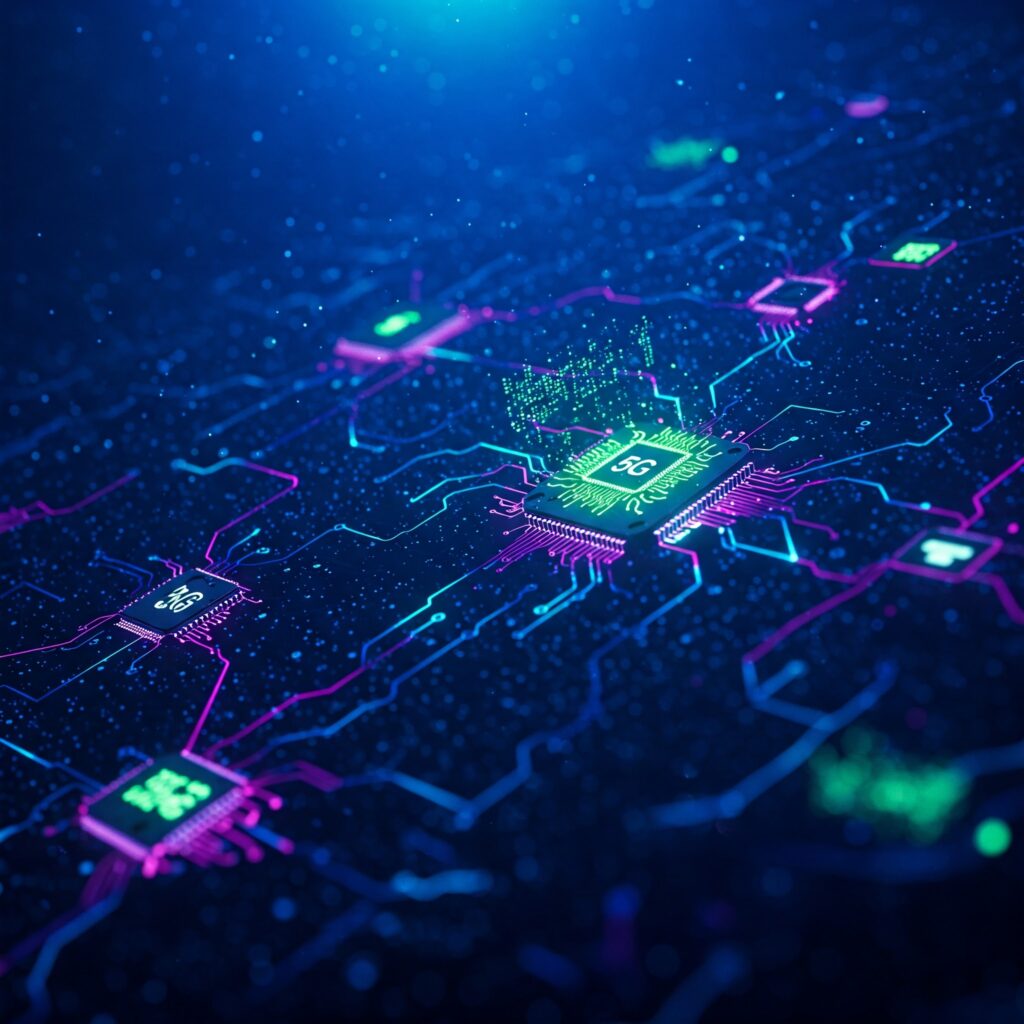The world of technology is accelerating at an unprecedented pace. What seemed like science fiction just a few years ago is rapidly becoming reality. We are on the cusp of transformations that will fundamentally reshape how we live, work, and interact with the world around us. Over the next 3-5 years, a confluence of powerful tech trends will move from exciting developments to pervasive forces, impacting everything from global industries to our daily routines. Get ready, because the future is arriving sooner than you think.
This article explores some of the most impactful technological waves building right now, offering a glimpse into a future powered by ubiquitous connectivity, intelligent systems, and a deeper integration of the digital and physical.
5G and 6G Connectivity
The Backbone of Tomorrow’s World
Faster internet is more than just quicker downloads. 5G, and its imminent successor 6G, represent a paradigm shift in connectivity, providing not only immense speed but also ultra-low latency and the capacity to connect a massive number of devices simultaneously.
- Why it matters: This isn’t just about your smartphone. 5G is essential for enabling real-time applications that require instantaneous communication, like remote surgery, autonomous vehicles, and complex industrial automation. It allows for seamless, high-definition data transfer, making technologies like AR/VR practical for widespread use. As 5G matures, we’ll see its full potential unlocked across smart cities, enhanced mobile broadband, and mission-critical communications.
- Looking ahead to 6G: While 5G deployment is still ongoing, research into 6G is already exploring even more ambitious capabilities, including speeds up to 100 times faster than 5G, further reduced latency, and the integration of AI into the network itself. 6G could enable truly immersive holographic communication and a hyper-connected environment where physical and digital realms are seamlessly merged.
- Real-world examples:
- Smart Manufacturing: Companies like Bosch are using 5G in their factories for flexible production lines and real-time monitoring of machinery.
- Autonomous Driving: Automakers like Waymo and Tesla rely on low-latency connectivity (increasingly 5G) for vehicle-to-vehicle and vehicle-to-infrastructure communication, crucial for safety and navigation.
- Telemedicine: Piloting of remote-assisted surgery and real-time patient monitoring is becoming possible thanks to 5G’s reliability and speed.

Artificial Intelligence (AI) Evolution
Intelligence Permeating Every Layer
Artificial Intelligence is no longer confined to research labs; it’s becoming deeply embedded in products, services, and decision-making processes across virtually every sector. The evolution of AI, particularly in areas like machine learning, deep learning, and generative AI, is creating systems that can learn, adapt, and perform tasks that previously required human intelligence.
- Why it matters: AI is a powerful tool for automation, analysis, and innovation. It can process vast datasets to identify patterns, make predictions, and optimize complex systems. From personalized medicine to predictive maintenance and creative content generation, AI is enhancing efficiency, enabling new capabilities, and changing the nature of work. We’re moving towards more sophisticated, context-aware, and even “agentic” AI systems that can take autonomous action.
- Real-world examples:
- Generative AI: Companies like OpenAI (with ChatGPT) and Google (with Gemini) are at the forefront, enabling text generation, code creation, image synthesis, and more, impacting creative industries, software development, and customer service.
- Healthcare: AI is used by companies like DeepMind for protein folding analysis, assisting in drug discovery, and by others for analyzing medical images to detect diseases like cancer with greater accuracy.
- Finance: AI algorithms are employed by financial institutions for fraud detection, algorithmic trading, and personalized financial advice.
Edge Computing
Processing Power Gets Closer
As the number of connected devices explodes, sending all data back to centralized cloud servers becomes inefficient and slow. Edge computing involves processing data closer to its source – on the device itself or on local servers – reducing latency and conserving bandwidth.
- Why it matters: Edge computing is critical for applications that require real-time responses and processing of sensitive data locally. It enhances the performance of IoT devices, supports autonomous systems, and improves data privacy and security by keeping data processing decentralized. This trend is crucial for the scalability and effectiveness of 5G/6G, AI, and the growth of the Internet of Things.
- Real-world examples:
- Manufacturing: Companies are implementing edge devices on factory floors to monitor equipment health, detect anomalies, and optimize processes in real-time without relying on a constant cloud connection.
- Retail: Edge AI is used for real-time inventory management, customer behavior analysis in stores, and enabling cashier-less checkout systems.
- Autonomous Vehicles: Vehicles process massive amounts of sensor data instantly at the “edge” (onboard) to make critical driving decisions.
Augmented Reality (AR) / Virtual Reality (VR)
Merging the Digital and Physical
Augmented Reality overlays digital information onto the real world, while Virtual Reality creates fully immersive digital environments. Often grouped under the umbrella of Extended Reality (XR), these technologies are moving beyond gaming and entertainment into practical applications across various industries.
- Why it matters: AR/VR is poised to change how we interact with information, train for jobs, collaborate, and experience entertainment. From enhancing employee training with realistic simulations to providing remote assistance with overlaid instructions and creating entirely new forms of social interaction and digital commerce, XR blurs the lines between the physical and digital worlds.
- Real-world examples:
- Training and Simulation: Companies like Boeing use VR for training aircraft mechanics, while healthcare providers use it for surgical simulation.
- Maintenance and Repair: Field technicians use AR glasses to access manuals and receive real-time guidance overlaid on the equipment they are working on.
- Retail and Design: Customers can virtually try on clothes or visualize furniture in their homes using AR apps. Companies like IKEA have been pioneers in this space.
Quantum Computing
Unlocking Unimaginable Power
Quantum computing leverages the principles of quantum mechanics to perform calculations that are impossible for even the most powerful classical computers. 1 While still largely in the research phase, progress is accelerating rapidly, moving closer to solving complex problems in fields like drug discovery, material science, and cryptography.
- Why it matters: Quantum computers have the potential to revolutionize industries by tackling problems currently considered intractable. They could lead to the development of new materials with unique properties, the creation of highly effective personalized medicines, breakthroughs in AI, and the ability to break current encryption methods, necessitating new forms of cybersecurity.
- Real-world examples:
- Research and Development: Companies like IBM, Google, and Microsoft are developing quantum hardware and software platforms, offering access to researchers and developers. IBM has been actively deploying and upgrading its quantum systems.
- Drug Discovery: Pharmaceutical companies are exploring quantum computing to simulate molecular interactions, potentially vastly accelerating the drug discovery process.
- Financial Modeling: Banks and financial institutions are investigating quantum algorithms for complex risk analysis and portfolio optimization.
Automation and Robotics
Working Alongside Intelligent Machines
Automation and robotics are becoming more sophisticated, moving beyond repetitive tasks on assembly lines to encompass more complex, perception-driven activities and human-robot collaboration. Advancements in AI, sensors, and mobility are leading to robots that are more versatile, autonomous, and able to work safely alongside humans (cobots).
- Why it matters: Increased automation and robotics are enhancing productivity, improving safety in dangerous environments, and enabling new levels of efficiency across industries like manufacturing, logistics, healthcare, and agriculture. This trend is reshaping the workforce, requiring new skills and fostering human-robot teamwork.
- Real-world examples:
- Logistics: Companies like Amazon heavily utilize autonomous mobile robots (AMRs) in their warehouses for sorting and transporting goods.
- Healthcare: Robotic surgery systems, like those by Intuitive Surgical (Da Vinci), allow for minimally invasive procedures with increased precision.
- Agriculture: Automated systems are being developed for tasks like precision planting, harvesting, and monitoring crop health, increasing yield and reducing labor needs.
Green Tech and Sustainable Innovation
Technology for a Greener Future
Addressing climate change and ensuring sustainability are becoming critical drivers of technological innovation. Green tech encompasses a wide range of technologies focused on renewable energy, energy efficiency, sustainable resource management, and environmental monitoring.
- Why it matters: As the urgency of environmental challenges grows, technology is providing solutions. Innovations in solar power, wind energy, battery storage, carbon capture, smart grids, and sustainable materials are essential for transitioning to a low-carbon economy and building a more sustainable world. This trend is not just environmental; it’s creating significant economic opportunities.
- Real-world examples:
- Renewable Energy: Companies like Ørsted (offshore wind) and First Solar (solar panels) are leading the deployment of large-scale renewable energy projects. Tesla is also a major player in battery storage solutions.
- Electric Vehicles (EVs): Beyond automakers like Tesla and BYD, companies are innovating in battery technology, charging infrastructure, and the integration of EVs into smart grids.
- Carbon Capture: Companies like Climeworks are developing direct air capture technology to remove CO2 from the atmosphere.
Preparing for the Future
The convergence of these technologies promises a future that is more connected, intelligent, automated, and potentially, more sustainable. While these advancements bring incredible opportunities, they also raise important questions about ethics, privacy, security, and the future of work.
Engaging with these trends means understanding their potential impact, both positive and challenging. Whether you are a professional looking to adapt your skills, a student choosing a career path, or simply a curious individual, staying informed about these technologies is key. The coming years will be defined by innovation – a future built on the foundations of faster networks, smarter systems, and a growing focus on technology that benefits both humanity and the planet. Embrace the change, explore the possibilities, and be a part of shaping the future.

